 |
Formation of Children
Chapter 27 - Table Manners Reveal
a Man’s Culture
Marian T. Horvat, Ph.D.
Many young men find themselves ill at ease at fine restaurants or banquet dinners. They are clumsy, awkward, embarrassed. Why? Because they are not sure about what to do with this line-up of silverware and that row of glasses. The uncomfortable youth butters a slice of bread and then realizes that others are breaking off a piece at a time and buttering it individually. He blows on the soup to cool it and wonder why eyebrows raise. In short, he is missing the knowledge and self-assurance that are the fruit of good table manners practiced daily.
The best time to learn good table manners is as a youth at the family table, but it is never too late to start. The man who strives to Catholic perfection is always eager to refine himself in all things, including his table manners.
The adroit and prudent young man knows how to cover for any possible shortcomings in his manners. There is, however, a particular moment when these inadequacies reveal themselves more clearly – it is the hour of meals taken in the company of others.
One’s posture, gestures, manner of eating and relations maintained with others at the table are visible and sure criteria to determine a person’s degree of culture. At meals one reveals whether he is accustomed to dine politely or is ignorant of general table etiquette.
Since the table is where one meets persons of the family and society, the laws of the table are important. The Golden Rule is expressed in two forms: avoid showing any discontent with what is served, and try to please one’s neighbor as much as it is fitting, without making disproportionate eulogies or lies. Superlatives, such as “This is the best roasted chicken I have ever had in my life” or other such overstatements, are cheap resources to please and shine that often produce the opposite effect. Be polite, but stay within the limits of the truth.
Catholic hospitality and the sincere desire of both host and guests to please one another constitute the principal elements that inspired table customs, and even the invention of many table utensils and items. Let us enter into some details on this topic.
Being punctual
Punctuality is a factor of order and harmony. Delay causes disorder in the daily schedule and work, causes inconvenience to others at the table, and disconcerts the cook.
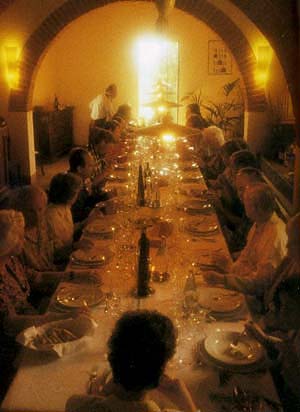
The Golden Rule to please your neighbor brings convivium to a dinner party |
At formal dinner parties, the rule is to arrive five minutes early, so as to greet the members of the house and other guests. A delay is not justified, even by the most skillfully prepared excuse. The rule is to foresee possible problems on the road in order to be able to arrive on time. If problems are anticipated, it is better to start some time earlier. Then, if no difficulties are encountered, one can find a place to sit and read, or pass a short time until the appointed hour.
Some persons wrongly imagine that to be late is a sign of one’s importance. Do not fall into this error. It is a discourtesy that only serves to disturb the dinner schedule, and will impress no one. The same rule that informs the guest to be punctual, tells the host to wait no more than 10 or 15 minutes to begin the planned meal. The host who follows good protocol will not change the sequence of courses to accommodate the late guest. It is the latecomer who must risk having his place at the table taken by another person, losing the appetizer and first course, and be the general cause of irritation to the entire party. We see that to be late does not promote anyone socially; rather it does the opposite.
At the table
At the dining table, the guest will occupy the place indicated to him, and will seat himself only after the host or head of the table is seated.
He will greet, if he has not already done so, the persons around him and will discreetly enter into conversation, guarding his words. Conversation at a formal dinner should be turned to cordial small talk, until a common subject of interest is found. When one is sure that his neighbor agrees with him on a particular topic, then a more open exchange of ideas may take place.
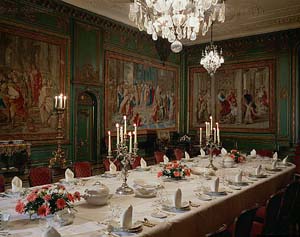
The formal banquet setting can be forbidding to the guest unlearned in table manners |
Are discussions allowed? This depends on the group of persons invited to the dinner, as well as the nature of the party. At the family table, in a circle of close friends, or in a social club, it is normal to have exchanges of ideas and opinions, insofar as respect and amiability are maintained. At a table with unknown persons, such as at a formal banquet, such discussions should be avoided. It is also disagreeable to have to listen to others proselytizing at a meal.
Avoid reports on one’s health, especially if prosaic details are involved. Should you dine with an older person suffering from well-known ailments, a short and courteous: “How is that bad ankle of yours?” or “Are you recovering well from your surgery?” suffices. The table is not the appropriate place to discuss medical problems and prescriptions.
Instead of trying to dominate the conversation, a young man will listen with interest to the topic of conversation chosen by the guests of honor or the head of the table.
If he has some point to raise, he should frame it as a question to the one speaking, remembering that elders like to be asked their advice or opinions. After his question is answered, he can enter easily into the conversation as an accepted party either asking another question or offering his opinion, without, however, appearing pretentious.
As he follows or joins in the conversation, he will keep an eye on what is going on with his neighbors with the aim of helping them if they need something. This should be a point of special attention if his table neighbors are elderly persons or ladies.
Unless he is at a restaurant or a club with close friends, he should not call a waiter from across the room. However he can take advantage of when the waiter passes to ask for the desired items.
Table settings
A disconcerting sight for the inexperienced dinner guest at a formal dinner is the array of glasses and silverware he faces at his place setting. It is not, however, as mysterious as it appears. The general rule to follow is simple: eating utensils are used from the outside in. Use a new utensil for each course (don't save your salad fork to use with the main course, for instance). When you don’t know what utensil to use, watch what your host does and follow suit.

Setting for a three-course meal and dessert |
The silverware at left is arranged for a three course meal and dessert: first, the salad course (salad fork, 4); second, the soup course (soup spoon, 7); third, the meat course (fork and knife, 5 and 6), and the dessert (dessert fork and spoon, 8). The smaller bread knife (9) is placed across the bread plate positioned to the upper left of the plate.
The water goblet (1), the largest, is placed above the knives. To its right and slightly in front of it is the red wine glass (2) or the smaller white wine glass (3).
In the next picture, one finds the formal banquet place setting, which is set European style, that is with the salad as the last course instead of the first. Therefore, the salad fork is next to the plate. There is a reason for this: it allows the diner to enjoy the fullest taste of the wines served with the fish and meat plates. Because the salad vinegar can affect the palate and change the taste of the wine, the salad comes after the main course instead of before it.
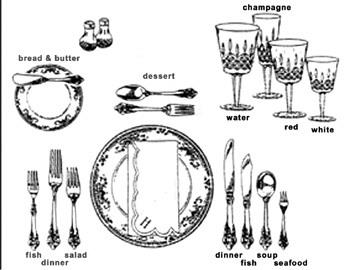
Setting for a five-course meal and dessert
|
This picture shows a setting for a five-course meal and dessert: the first, the shellfish plate (seafood, or oyster fork), the soup course (soup spoon), the fish course (fish fork and knife), the meat course (dinner fork and knife), the salad (salad fork), and the dessert (dessert fork and spoon).
The glasses include the water glass to the extreme left, followed by the champagne glass placed a little behind the others since the champagne is served at the dessert, and then the red wine and white wine glasses, placed according to size to allow the diner easy reach. If the dinner is served by waiters, they will remove the white wine glasses with the fish plates and the red wine glasses with the meat plates, leaving only the water and the champagne glasses for the dessert.
There are two acceptable ways to use a knife and fork: American style and European style. In the American style, one holds the knife in the right hand, and fork in the left. Cut a piece of meat, then place the knife on the edge of your plate (with the blade facing in), then switch your fork to your right hand to eat (unless, of course, you're left-handed).
In the European style, hold the knife in your right hand, the fork in the left. You do not switch hands - you eat with your fork in your left hand. [See a video of how to eat Continental-style here]
It is amazing how many youths today do not know the most elementary table etiquette: the correct way to hold the fork. The proper way is to balance the utensil between the first knuckle of the middle finger and the tip of the index finger, while using the thumb to support the handle. When you use a knife, the tip of your index finger should rest on the upper blade of the knife. Never hold the utensil in a full-fisted way.
Begin eating only after everyone at the table has been served.
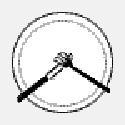
Above, this tells the waiter you have not finished the plate
Below, this signals you are finished
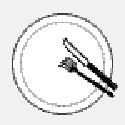 |
The placement of flatware when not in use acts as a message to the well-educated host or waiter, allowing the diner to indicate whether he has paused in eating, will eat more, or has finished the plate. When a guest finishes his salad and soup, the salad fork and the soup spoon should be set across the plates. If you would like another serving of soup, place the top of your spoon (concave side down) on the edge of the plate, with its handle setting on the table. At formal dinners it is not advisable to ask for a second helping because such requests will delay the service schedule.
When a guest finishes eating the fish and meat courses, he signals this by setting the fork and knife parallel to each other, either across the center of the plate or diagonally with the handles pointing to the right. The cutting edge of the knife faces the diner and the fork tines are preferably up.
If the diner has not finished, he indicates this by setting the fork on the left and the knife on the right so that they cross over each other in the center of the plate. The diner preparing to pass his plate for a second helping places the fork and knife parallel to each other at the right side of the plate, so that there is room for the food.
The good waiter will know how to distinguish these codes, and never ask the stupid question: “Are you still working on this?” When the guest does not know these rules, the polite waiter will approach with the tray to ask: “Will you accept a little more?” or inquire “May I take your plate?”
The general rule for serving, easily memorized, is: serve left and remove from the right. That is with food. As far as beverages, you serve them from the right. At a dinner with several courses, the used plate and corresponding silverware and wine glass are removed from the right. If a guest is still enjoying the wine served with that course, the glass should be left on the table.
At a formal dinner or banquet, food should be presented to guests in the following order: guest of honor, female guests, male guests, hostess, host. At restaurants, the meals are generally served first to the women, then to the men, with the older served before the younger. During the meal, it is standard practice to pass to the right. The salt and pepper should be passed together.
When the meal is finished, fold your napkin neatly and set it to the right of the plate.
The meal table is no place for a purse or briefcase or other personal belongings – no matter how small. Personal effects should be placed on the floor, your lap, or hung on the chair. An exception to this rule is when the lady has a very small banquet purse, which she may set on the table at her right side, next to the silverware. If you have a cell phone with you, be sure it is turned off and placed out of sight. It is a breach of consideration for others to answer your cell phone during a meal. In the event of an emergency, apologize beforehand for having to answer your phone, then leave the table and talk outside of the room.

Posted February 18, 2008


Related Topics of Interest
 Eating Alone Eating Alone
 Fast Food Is Protestant Fast Food Is Protestant
 Manners Make Life Easier Manners Make Life Easier
 Courtesy in the Catholic Home Courtesy in the Catholic Home
 Chapter 18: Let's Not Forget the Greeting Chapter 18: Let's Not Forget the Greeting
 Chapter 19: The Blessing Chapter 19: The Blessing
 Chapter 20: The Family Milieu Chapter 20: The Family Milieu
 Chapter 21: A Youth's Relations with His Superiors Chapter 21: A Youth's Relations with His Superiors
 Proper Behavior for Visits - Part I Proper Behavior for Visits - Part I

Related Works of Interest
|
|
Formation | Cultural | Home | Books | CDs | Search | Contact Us | Donate

© 2002- Tradition in Action, Inc. All Rights Reserved
|
 |
|